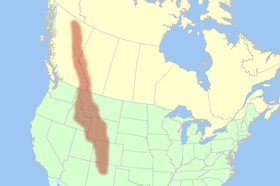Central Rocky Mountains
| Rocky Mountains | |
|---|---|
|
the Rockies (en), les Rocheuses (fr), Montañas Rocosas, Rocallosas (es) |
|

|
|
| Highest point | |
| Peak | Mount Elbert (Colorado, United States) |
| Elevation | 14,440 ft (4,401 m) |
| Coordinates | 39°07′03.90″N 106°26′43.29″W / 39.1177500°N 106.4453583°W |
| Dimensions | |
| Length | 3,000 mi (4,800 km) |
| Geography | |
| Countries | Canada and United States |
| States/Provinces | |
| Range coordinates | 43°44′N 110°48′W / 43.74°N 110.8°WCoordinates: 43°44′N 110°48′W / 43.74°N 110.8°W |
| Parent range | North American Cordillera |
| Geology | |
| Age of rock | Precambrian and Cretaceous |
| Type of rock | Igneous, Sedimentary and Metamorphic |
The Rocky Mountains, commonly known as the Rockies, are a major mountain range in western North America. The Rocky Mountains stretch more than 3,000 miles (4,800 km) from the northernmost part of British Columbia, in western Canada, to New Mexico, in the southwestern United States. Within the North American Cordillera, the Rockies are somewhat distinct from the Pacific Coast Ranges and the Cascade Range and Sierra Nevada which all lie further to the west.
The Rocky Mountains were initially formed from 80 million to 55 million years ago during the Laramide orogeny, in which a number of plates began to slide underneath the North American plate. The angle of subduction was shallow, resulting in a broad belt of mountains running down western North America. Since then, further tectonic activity and erosion by glaciers have sculpted the Rockies into dramatic peaks and valleys. At the end of the last ice age, humans started to inhabit the mountain range. After Europeans, such as Sir Alexander Mackenzie, and Americans, such as the Lewis and Clark expedition, started to explore the range, minerals and furs drove the initial economic exploitation of the mountains, although the range itself never became densely populated.
Currently, much of the mountain range is protected by public parks and forest lands, and is a popular tourist destination, especially for hiking, camping, mountaineering, fishing, hunting, mountain biking, skiing, and snowboarding.
...
Wikipedia

